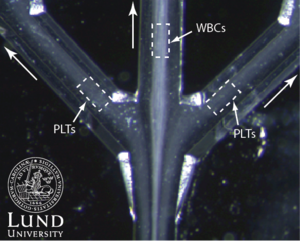Platelets
Acoustical removal of platelets
Excessive collection of platelets is an unwanted side effect in current centrifugation-based peripheral blood progenitor cell (PBPC) apheresis. The difference in size between platelets and PBPCs and the difference in acoustic force that come with that difference in acoustophysical properties allowed us to do acoustical removal of platelets from PBPC products.
PBPC samples were obtained from patients (n=15) and healthy donors (n=6) and sorted on an acoustophoresis-chip. The acoustic force was set to separate leukocytes from platelets into a target fraction and a waste fraction, respectively (see image below). The PBPC samples, the target and the waste fractions were analysed for cell recovery, purity and functionality.

The median separation efficiency of leukocytes to the target fraction was 98% whereas platelets were effectively depleted by 89%. PBPC samples and corresponding target fractions were similar in the percentage of CD34+ hematopoetic progenitor/stem cells as well as leukocyte/lymphocyte subset distributions. Median viability was 98%, 98% and 97% in the PBPC samples, the target and the waste fractions, respectively. Results from hematopoietic progenitor cell assays indicated a preserved colony-forming ability post-sorting. Evaluation of platelet activation by P-selectin (CD62P) expression revealed a significant increase of CD62P+ platelets in the target (19%) and waste fractions (20%), respectively, compared to the PBPC input samples (9%). However, activation was lower when compared to stored blood bank platelet concentrates (48%).
It can be concluded that acoustophoresis can be utilized to efficiently deplete PBPC samples of platelets, whilst preserving the target stem/progenitor cell and leukocyte cell populations, cell viability and progenitor cell colony-forming ability.
References
Dykes J., Lenshof A., Åstrand-Grundström I., Laurell T. and S. Scheding, Efficient removal of platelets from peripheral blood progenitor cell products using a novel microchip based acoustophoretic platform, PLoS ONE, 2011, 6, e23074
